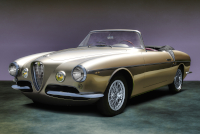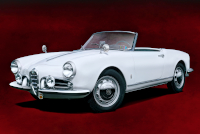Location:
Elegance at Hershey, 2016
Owner: Stephen & Kim Bruno | Boca Raton, Florida
Prologue:
Instantly recognizable from Villa d'Este, the Ghia-Aigle cabriolet is among those rare luxury Alfa Romeo cars of the post-War era. A proper car of the Italian coachwork tradition, the cabin caught my attention with its colorful, grand touring pretensions. I might have taken more care to work with the fascia, but prepared an economical four-shot survey. Brief, though I like the results.
- - - - - - - - - -
► Image Source: Nikon D750 (24.3 MP)
References:
- Czap, Nick. "Museo Storico Alfa Romeo: The Catalogue" Giorgio Nada Editore, Milano, Italia. 2015, page 62-65
- d'Amico, Stefano. "Pure Alfa Romeo" Libri Illustrati Rizzoli, Milano, Italia. 2017, page 36, 100-108
- Hemmings Motor News: "This Swiss-coachbuilt Alfa Romeo 1900C Super Sprint is one of a kind" by Richard Lentinello. July, 2020. A very nice article detailing the car's history and restoration.
- UltimateCarPage: See also this proper 30-shot gallery of #AR1900C-01959 from Villa d'Este and Pebble Beach, by Wouter Melissen, July 21, 2014.
- Coachbuild: A brief survey of #AR1900C-01942, the 1900 CSS Cabriolet La Flèche by Vignale, Michelotti's sister show car (Turin) to this Ghia-Aigle example (Geneva).
Following the war, Alfa Romeo transitioned from building exclusive coachbuilt automobiles to a much-needed populist approach. While the 1900 became the first of these production automobiles, Alfa also produced up-rated, short-chassis versions for the coachbuilder community; these began with the 1900 C Sprint and, in 1954, the Super Sprint. Power comes from a twin-carb, chain-driven dual overhead cam inline four-cylinder. If not built on grand prix success, as its pre-war ancestors, the motor shares in the success of the 1900 TI, or 'Turismo Internazionale,' which enjoyed class victory in Italy's domestic road racing scene. By 1955, power increased to 115 horses, controlled by a five-speed, column-shift gearbox that Alfa designed and built in-house. The column-shift box would last until 1956.
Most of these 1900 C Sprint and Super Sprint cars used Touring coachwork, very much becoming the spiritual successors to the 6C 2500 cars of the previous, transitional decade. An emerging part of the modern Alfa Romeo story, these new designs advanced the pre-War concept of a singular, fluid shape, quickly approaching the three-box concept that would become industry standard a decade later. Touring used features of the 6C 2500 to establish brand identity, but with both a lighter and more muscular appeal. Meanwhile, Pinin Farina penned clean flanks and elegant lines for the 1900, building on the success of their acclaimed Cisitalia 202. And when pressed to the task, Zagato would prove the most aggressive, most outrageous of the bunch. So with all the big names in Italian coachbuilding busy crafting a new-world Alfa Romeo dream, the Alfa Romeo dealer in Lugano, Switzerland bought a rolling Super Sport chassis and asked its local coachbuilder to prepare a car for the 1955 Geneva Motor Show. That car is AR1900C-01959.
The 1900 retains a sense of Alfa Romeo's classic era roots. However, note that in 1954 Alfa Romeo introduced the Giulietta, a car that would sell over 177,000 units through 1965. Figures vary from 177,513 to 177,690, but the point in mentioning Giulietta production is that, while it debuted four years later, the Giulietta in its many forms out-sold the 1900 by about ten to one. Meanwhile, the 1900 would progress to the 2000, then the 2600, offering platforms for custom coachbuilders to ply their craft. These cars would occupy a prestige role for road-going Alfas, grand touring cars along the likes of early, small-capacity Ferrari and Maserati cars, whereas the Giulietta cars would take over the duty of winning petrol-pumping hearts in the broader market.
Carrozzeria Ghia and the Ghia-Aigle 1900 CSS
Carrozzeria Ghia established Ghia-Aigle as a subsidiary in 1948. The firm became independent in 1953, and would only be located in Lugano from 1954 to 1958. Though small, Ghia-Aigle benefitted from Ghia's own designers, names that read like the high Renaissance of coachbuilding—first, Mario Boano and Giovanni Michelotti, and following them, Pietro Frua. The design of 01959 is a Michelotti product, and one of many from the mid-1950s that demonstrates American and Italian influences crossing back and forth across the Atlantic. Very much of-the-moment, 01959 also exhibits features not seen on other period Alfa Romeo cars, coachbuilt or otherwise.
For many years, 01959 wore bright red paint with a saddle-tan interior, appearing in that livery for sale in Florida in the first decade of the 21st century, having spent much of its life in Europe. The Brunos undertook restoration to its original Geneva Motor Show presentation. Adverts for the car as sold commented on the presence of the original gold paint, much better than its retail red respray. Following restoration, the Alfa became a strong statement for Ghia-Aigle history, representing the coachbuilder and the marque at Pebble Beach in California and Villa d'Este on Lake Como in Italy.
Motor: 1,975 cc straight 4-cylinder, cast iron block, light-alloy hemi-head | 84.5 mm x 88 mm | 8.0:1 compression
Valvetrain: DOHC, chain-driven, 2 valves per cylinder
Aspiration: twin Solex PII carburetors
Power: 115 bhp at 5,000 rpm
Drivetrain: 5-speed gearbox, column-shift, rear-wheel drive
Front Suspension: independent via unequal A-arms, coil springs over tube shocks, and an anti-roll bar
Rear Suspension: live axle located by longitudinal radius arms and a triangulated central link, tube shocks and coil springs
Architecture: part unitary construction with coachwork by Ghia-Aigle
Although the 1900 is a mass-produced unit-body exercise, Alfa Romeo provided five modified platforms for the Italian coachbuilding industry over the model's nine-year program. The platform owes its flexibility in part to a rigid lower body section (the base), which allowed coachbuilders to create cabriolet versions early in the 1900's production run. Pinin Farina often received these open-top orders, whereas this Giovanni Michelotti design is an original show car, complement to his 1900 SS La Flèche Cabriolet, built by Vignale.
Wheelbase: 2,500 mm (98.4 in)
Etymology:
'1900' refers to the displacement, which began at 1,884 cc with the original series in 1950, later 1,975 cc as in this example. The 'C' designation denotes a short chassis, or 'corto,' while the 'SS' stands for 'Super Sprint,' the 1954 successor to the 1900 C Sprint. Ghia-Aigle is the Swiss coachbuilder, small, though stocked with the talent of Mario Boano, Pietro Frua, and Giovanni Michelotti.
Figures:
Though part of Alfa Romeo's first production car operations, chassis #AR1900C-01959 is a unique example designed by Giovanni Michelotti for the 1955 Geneva Motor Show.
Front-Loaded: Heavy Design Work on the Alfa Romeo 1900 Fascia
Much of the design happens at the front. The fascia uses a four-light arrangement, reminiscent of the 6C 2500 SS. The central grille sits within a deep recess on a prominent nose, which, in concert with the outboard headlight pontoons, creates classically inspired soffits. The grille itself uses a heart-shaped shroud, creating a multi-layer dish that makes a secret of the car's most characterful feature. Almost taking the opposite approach, the two lower vents that complete the Alfa tri-lobe theme hold a set of large, wrap-around chrome guards. Four lights. Three recesses. Three chrome elements. The fascia precisely places these elements on a highly figured nose and bonnet. The only detraction is a pair of conical indicators; perhaps concessions, they are rather large.
Deep Dish: Unexpected Belly-Tanker Shape in Michelotti Alfa Romeo Designs
At first I found it surprising how deeply the body wraps under the fascia, almost a belly-tanker approach. But the depth of the body itself is not unusual for the Alfa 1900, just the degree to which the body is sculpted. Viewed from the front quarter perspective, the girth is somewhat incongruous, with more fully rounded shape under the front than beneath the tail. Conversely, from the tail, the design emphasis sits up on the fins, offset by a long deck. The shape suggests there is a lot of car to cover, and Michelotti did not shy from imbalance. His 1900 CSS Cabriolet La Flèche design, which Vignale built in 1955 (#AR1900C-01942), displays a similar leap-forward attitude. These two cars supported the show scene for their respective carrozzerie, the Ghia-Aigle car depicted here appearing at Geneva, and the Vignale car appearing at Turin.
American Influence: Finding Transatlantic Influence in the Ghia-Aigle Cabriolet
Working around the tail, we see more of the transatlantic style exchange that defined American and Italian cars in the 1950s. Ghia had already established a fruitful relationship with Chysler, and contemporary Ghia-Aigle designer Boano had satisfied some incredible design briefs. With Michelotti's emerging western influence, designs such as this Alfa Romeo fit the pattern. The tall chrome shoulder piece aft of the door, airline-style tailpiece above the number plate, and tail fins all bring American jet-age styling to a Mediterranean coastal cruiser.
More than simply adding American influence, breaking up the flank with a high, chrome shoulder creates a kink in the car's soft lines, changing the angle of the body because the fins travel along their own plane, separate from the shoulder line to that point behind the door. The effect is interesting, though perhaps better digested with the hood up.
Another intriguing difference, front to back, is that the front wheel arch uses a flared lip around the radius, whereas the rear does not. That difference in itself serves as a marker that the tail and the nose are each separate propositions, as suggested above. Viewed as a whole, 01959 exhibits a strange duckling persona—not entirely sure of itself because its first impression isn't quite the same as its parting remarks.
Last Updated: Mar 26, 2025





